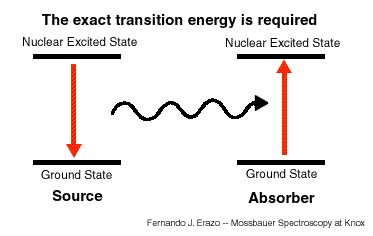THE THEORY BEHIND MOSSBAUER SPECTROSCOPY
![]()
| The Beginnings: Rudolf Ludwig Mössbauer |
Rudolf Mossbauer, in 1958, discovered the recoil-free emission and absorption of gamma rays by nuclei. At the time it was thought impossible for nuclei to absorb and emit gamma rays resonantly. It was believed that due to conservation of momentum, the emitting and absorbing nuclei would lose some of the gamma ray energy by recoiling, therefore eliminating any chance of the gamma ray being absorbed again by another nucleus - this due to the very narrow linewidth of some nuclear energy levels (due to their long lifetime - the uncertainty principle!) In 1958, however, Mossbauer showed that if the absorber and emitting atoms are embedded in a lattice (the quantum mechanical perspective of a solid) the recoil due to the gamma ray may in fact be taken up by the entire solid, making the energy loss negligible.. brilliant! This is in fact the very essence of Mossbauer Spectroscopy: the discovery of recoil-free nuclear resonance emission and absorption.
Mossbauer himself was born in Munich and he obtained a Ph.D. degree in physics from the Technical Institute in Munich in 1958 (at age 29). After his discovery he gained world recognition and moved to the United States in 1960. He went to the California Institute of Technology. In 1961, he was awarded the Nobel prize in physics for his 1958 discovery.
| The Mossbauer Effect: Recoil-Free Nuclear Radiation |
The Mossbauer effect states that when some atoms are held tightly in crystalline atomic structures, the gamma radiation emitted by their nuclei are very close to being recoil-free. This implies that the emitted photon has the exact frequency that corresponds to the transition energy between the nuclear ground state and the excited state. When this photon carrying the full nuclear transition energy strikes another similar nucleus also embedded in a tight crystalline structure, absorption may occur. Because the nuclear energy levels are very sharply defined, only such a photon - one that carries the exact transition energy - may excite another nucleus (of course, only if absorber doesn't recoil either). A simple schematic is shown below:

Because of the very narrowly defined nuclear energy states, the smallest change in the energy of the photon will destroy the resonance. Thanks to this extreme sensitivity, Mossbauer spectroscopy has proven itself an excellent method to measure otherwise impossible to detect nuclear energy differences. Minuscule energy variations, magnetic fields at the nucleus, and even distortions or asymmetries in the shape of the lattice that encloses the atom are enough to produce shifts and split tings in the absorption line. All these alterations of the nuclear environment that produce an observable effect are called the nuclear hyperfine interactions.
| Mossbauer Measurements: The Hyperfine
Interactions |
The nuclear isomer shift – electric monopole interaction:
The isomer shift originates from the Coulomb interaction of the nuclear charge distribution over the radius of the nucleus in its ground and excited state, and, the electron charge density AT the nucleus. It results in a shift of the overall spectrum to higher and lower energies. The isomer shift depends most strongly on the ionization state of the atom, as shielding effects due to valence electrons will influence the s-electron density at the nucleus.
The nuclear quadrupole splitting – electric quadrupole interaction.
The quadrupole splitting results from the interaction between the Electron Field Gradient (EFG) at the nucleus and the electric quadrupole moment eQ of the nucleus itself. More specifically, the EFG at the nucleus will split the Fe57 nuclear excited I = 3/2 state into a pair of doublets: Iz = +/- 1/2 and +/- 3/2.
The nuclear Zeeman effect – magnetic dipole interaction.
The nuclear magnetic dipole moment interacts with an applied magnetic field B to produce this splitting of the energy levels at the nucleus.
Besides these three hyperfine interactions there are other measurable interactions called the relativistic effects. These are caused by a temperature or pressure changes, and acceleration and gravitational fields.
To see an illustrative hyperfine interactions table, click here.